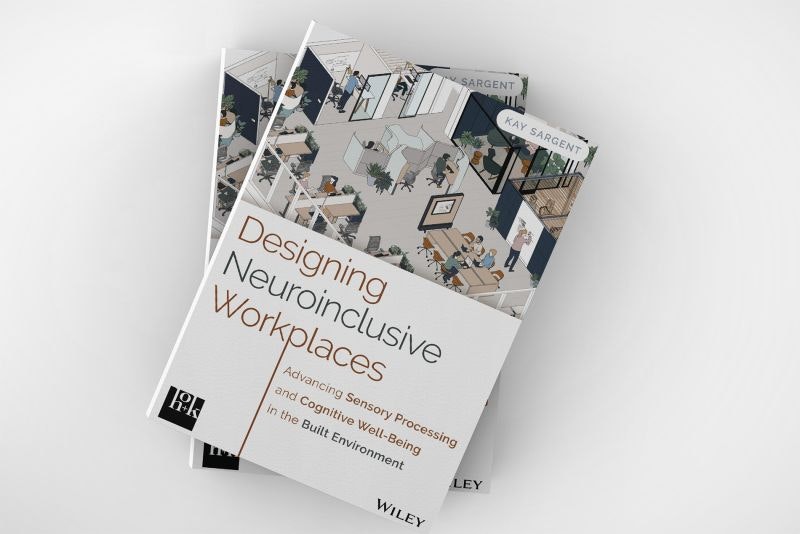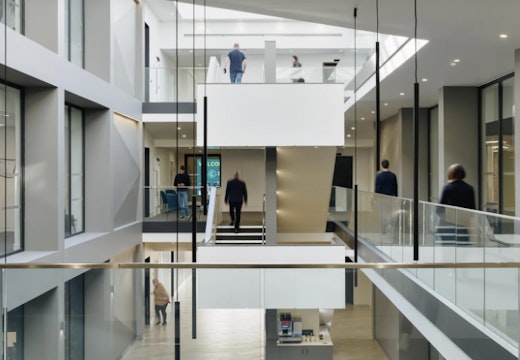Designing neuroinclusive workplaces: how to get started
Many companies have a desire to create a flourishing workplace for all but are struggling to make it happen. A new book by Kay Sargent of architects HOK demystifies the process
Neurodiversity is a difference, not a deficit.
Today it is estimated that one in five individuals is neurodivergent, which is a natural reoccurring variation in neurocognitive functioning. When we started our research into this topic eight years ago, the statistic was one in eight. But our research is showing that even one in five is likely very conservative and it might be closer to being one on three. Neurotypes include Autism, ADHD, Dyslexia and Tourette’s Syndrome, to name a few.
Our understanding of disability and the role inclusive design plays in supporting neurodiversity continues to evolve. But we also know that many companies that are embracing the concept of neuroinclusion in the built environment might also be struggling to determine how to get started.
In March of 2025, the architectural firm HOK, where I am a principal, launched a comprehensive book on neurodiversity entitled Designing Neuroinclusive Workplaces. The book addresses sensory processing, cognitive wellbeing and neurodiversity in the build environment, and the steps for creating more welcoming, inclusive spaces. Here are some highlights from the book to help get you started.
Removing barriers
Workplace barriers can be both physical obstacles (such as inaccessible building entrances) and operational protocols (such as policies requiring people to work without breaks). Reasonable accommodations should be designed to address specific individual needs, remove barriers, and make work conditions more inclusive, giving all individuals an equal opportunity to enjoy the benefits and privileges of employment.
From our experience, organisations that have successfully embraced neurodiversity in their workplaces have undertaken programs that bring awareness, educate, and sensitise their teams to what their organisation is trying to achieve and how to meet those goals.

Steps for inclusion
That systematic approach to creating an inclusive workplace can include the following steps:
- It starts with consulting with professionals early in the process.
- Then it’s all about educating your team and raising awareness.
- Then we need to access how we are today and perform a space audit.
- We need to make sure we have the right people at the table. HR, IT, the employee resource groups and employees themselves.
- We need to engage with neurodivergent employees, ask what they need and listen.
6-8. And then the design process starts with creating the right settings, planning concepts, sequencing and design strategies.
- We need help people imagine what a day-in-the-life could be by developing journey maps.
- And we need to continually assess to see if there’s opportunities for improvement or adjustments, so we can evolve as our knowledge does.
The starting point
One of the key steps to moving forward is understanding where you are starting from. If asked whether their organization and spaces are designed to be neuroinclusive, most people could not answer that question because there is no clear definition of what that means.
A workplace audit can help employers, HR teams, and corporate real estate teams evaluate the current state of neuroinclusivity in their facilities. The assessment can also provide a roadmap for identifying additional planning and design elements that can help create a more inclusive work environment.
The team at HOK has developed a list of design considerations that can also function as a checklist to aid in assessing existing spaces to identify potential modifications and determine considerations to improve inclusion. Our teams have leveraged this tool to assess: the current condition for each suggested accomodation; whether making an accommodation is reasonable; whether the accommodation is actionable; and recommendations for moving forward.
Prioritising recommendations
Once a primary assessment is complete, recommendations can be prioritised based on a ranking system that looks at impact, cost and ease of implementation. The checklist includes an evaluation system to rank the viability of each suggestion based on:
- Actionable: Degree of difficulty in implementation
- Effective: Level of impact for users
- Affordable: Cost and financial viability
- Aligned: Compatibility with the organisation’s goals and values
The assessment and ranking can help organizations to see where they stand, identify strategies to make their space more inclusive, and prioritise how to do so. For example, a recommendation that is high impact, low cost and easy to implement may be given a higher priority than one that is low impact, higher cost and more complex to implement.

Through inclusive design practices, we can create environments that proactively address diverse employee needs, often eliminating the need for individual accommodations later. When thoughtfully integrated into the initial design process, these inclusive features typically do not increase overall project costs.
Learn more about neurodiversity, why it’s great for business, the findings from our research and how create spaces where all can thrive, here.
Designing Neuroinclusive Workplaces by Kay Sargent is published by Wiley (2025).
Review WORKTECH Academy’s Expert Session with Kay Sargent in our Innovation Zone.
 Kay Sargent is the director of thought leadership in HOK’s Interiors group. Based in Washington D.C., she collaborates with organisations ranging from tech startups to Fortune 500 companies to optimize their real estate portfolios and create the most innovative work experiences.
Kay Sargent is the director of thought leadership in HOK’s Interiors group. Based in Washington D.C., she collaborates with organisations ranging from tech startups to Fortune 500 companies to optimize their real estate portfolios and create the most innovative work experiences.







